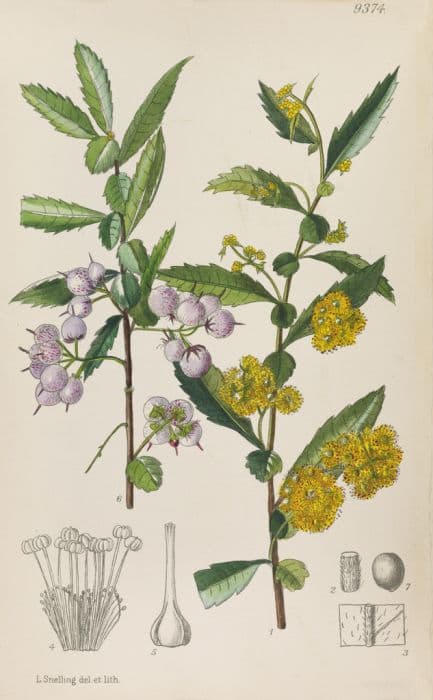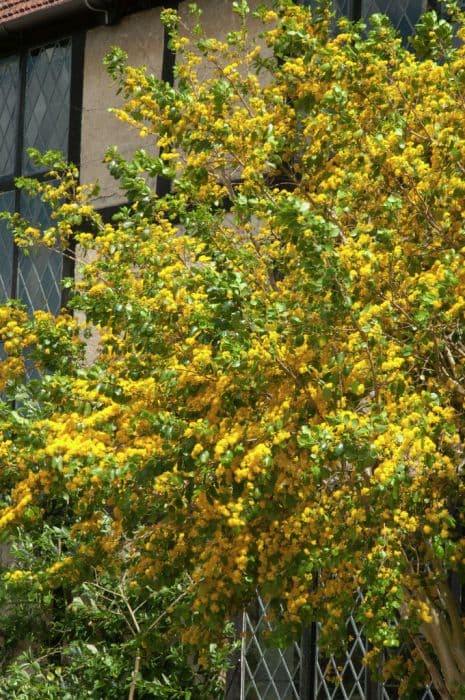Swedish Columnar Aspen Populus tremula 'Erecta'

ABOUT
Populus tremula 'Erecta', commonly known as the columnar aspen, is a unique and visually striking tree characterized by its narrow, upright growth habit. This type of aspen boasts a tall, slender profile with branches that grow mostly upward rather than outward, which contributes to its column-like appearance. The leaves of the columnar aspen are, similar to other aspen varieties, somewhat rounded to heart-shaped with finely toothed edges. They are particularly noted for their fluttering movement in the wind, which gives the tree its name; "tremula" means trembling. During the growing season, the leaves are a vibrant green color that catches the light due to their trembling nature. In autumn, the foliage undergoes a dramatic change, turning brilliant shades of yellow, gold, or sometimes red, providing a stunning display. The bark of the columnar aspen is typically pale, ranging from creamy white to light green or gray, and is often marked with dark horizontal lines known as lenticels. While the columnar aspen's branching structure is dense, it retains a slim profile overall, making it an attractive choice for areas where space is limited but vertical emphasis is desired. Its roots are typically wide-spreading and shallow, a characteristic of many aspen trees. The columnar aspen is favored for its aesthetic appeal as well as its adaptability, as it can grow in a variety of soil conditions and climates, barring extreme conditions. It is often used in landscape design to create vertical accents or to form allees and borders.
About this plant
 Names
NamesFamily
Salicaceae
Synonyms
Swedish Columnar Aspen, European Quaking Aspen, Erect European Aspen
Common names
Populus tremula 'Erecta'.
 Toxicity
ToxicityTo humans
Populus tremula 'Erecta', commonly known as the Swedish Aspen, is not typically recognized for having significant toxicity to humans. While nearly all plants can cause some degree of discomfort if ingested due to natural plant compounds, there are no well-documented or commonly known toxic effects directly attributed to the Swedish Aspen that suggest severe poisonings or life-threatening consequences. However, individual sensitivities can vary and some people may experience mild stomach upset or an allergic reaction upon ingestion or handling of the plant. It is always prudent to avoid consuming parts of ornamental plants due to potential unknown toxins.
To pets
Swedish Aspen is generally not listed among plants that are toxic to pets. There is no widely acknowledged evidence that suggests significant toxic risks associated with pets ingesting this particular species of aspen. However, as with humans, individual animals may have different sensitivities, and it's possible for pets to experience mild gastrointestinal upset if they ingest parts of the plant. For safety, it's best to prevent pets from chewing on any ornamental plants to avoid any potential adverse reactions.
 Characteristics
CharacteristicsLife cycle
Perennials
Foliage type
Deciduous
Color of leaves
Green
Height
40-50 feet (12-15 meters)
Spread
10-20 feet (3-6 meters)
Plant type
Tree
Hardiness zones
2-8
Native area
Europe Asia
Benefits
 General Benefits
General Benefits- Aesthetic Appeal: Provides a narrow, upright form that creates a striking vertical element in landscapes.
- Adaptability: Tolerates a wide range of soil types and is hardy in cold climates.
- Color Change: Offers seasonal interest with leaves that turn a golden yellow in autumn.
- Shade Provision: Can be used to provide focused shade because of its tall and narrow growth pattern.
- Windbreak: Serves as a windbreak due to its height and dense foliage, reducing wind speed in gardens and on properties.
- Habitat Support: Provides habitat and food for wildlife, such as birds and insects.
- Erosion Control: Its root system stabilizes the soil, helping to prevent erosion especially on slopes.
- Ornamental Bark: Features interesting bark that adds to its visual appeal during winter months.
- Growth Rate: Has a relatively fast growth rate, which quickly establishes the landscape.
 Medical Properties
Medical Properties- This plant is not used for medical purposes.
 Air-purifying Qualities
Air-purifying QualitiesThis plant is not specifically known for air purifying qualities.
 Other Uses
Other Uses- Acoustic Control: Due to its dense growth habit, Populus tremula 'Erecta', commonly known as the Swedish Columnar Aspen, can be used to reduce noise pollution by acting as a natural sound barrier.
- Soil Erosion Prevention: Its widespread root system helps stabilize soil, preventing erosion on slopes and in areas prone to heavy rains.
- Windbreaks: The tightly columnar form of the Swedish Columnar Aspen makes it an ideal choice for planting in rows to serve as windbreaks to protect more vulnerable plants or structures.
- Artistic Inspiration: The unique tremble of its leaves in the wind has inspired artists and photographers who use the tree as a subject for their work.
- Education: This tree is often used in educational programs to teach about clonal colonies and vegetative reproduction, a characteristic shared by many Populus species.
- Wildlife Habitat: The tree provides habitat and food for local wildlife, such as birds which may nest in its branches and feed on the catkins.
- Winter Interest: The tree’s distinct, upright branching pattern adds visual interest to landscapes during the winter months when the leaves have fallen.
- Urban Greening: The Swedish Columnar Aspen is often planted in urban environments to create green corridors that improve the aesthetics of cityscapes.
- Seasonal Festivities: Its leaves and branches can be used for seasonal decorations due to their unique appearance, particularly in the fall when leaves show vibrant colors.
- Craft Materials: The slender branches of the Swedish Columnar Aspen can be harvested and used for making small handcrafts or in rustic floral arrangements.
Interesting Facts
 Feng Shui
Feng ShuiThe plant Aspen is not used in Feng Shui practice.
 Zodiac Sign Compitability
Zodiac Sign CompitabilityThe plant Aspen is not used in astrology practice.
 Plant Symbolism
Plant Symbolism- Adaptability – Populus tremula 'Erecta', or the Swedish Columnar Aspen, is known for its ability to thrive in various soil types and environmental conditions, symbolizing the ability to adapt and persist through changing circumstances.
- Resilience – The Swedish Columnar Aspen can withstand cold climates and strong winds, representing resilience and the strength to stand firm against adversity.
- Communication – Aspens are known for their trembling leaves that create a rustling sound in the wind, which can be symbolic of the importance of communication and interconnectedness in a community.
- Growth – With their fast-growing nature, Swedish Columnar Aspens represent rapid growth and development, both personally and in one's career.
- Protection – The dense foliage and the columnar shape of the tree can offer a protective screen, symbolizing shelter and safety in life's diverse situations.
 Water
WaterThe Swedish Columnar Aspen prefers moist but well-drained soil, so it's important to water deeply but allow the soil to dry slightly between watering sessions. Generally, during the growing season, water approximately 2-3 gallons per week, depending on rainfall and soil conditions. During hot or dry spells, increase watering frequency to prevent stress. Cut back on watering during the fall to help the tree prepare for winter, but ensure that the tree enters the winter with moist soil.
 Light
LightSwedish Columnar Aspen thrives in full sun, meaning it should receive at least six hours of direct sunlight each day. The ideal spot for this plant is an open area away from larger trees and structures that may cast shade, ensuring it gets ample light throughout the day to support healthy growth.
 Temperature
TemperatureSwedish Columnar Aspen is fairly cold-hardy and can tolerate a wide range of temperatures. It can survive winter temperatures well into the negative range, down to around -40 degrees Fahrenheit, but the ideal growing temperatures are between 60 and 75 degrees Fahrenheit. During summer months, the tree can tolerate highs up to around 90 degrees Fahrenheit without serious stress.
 Pruning
PruningPrune the Swedish Columnar Aspen in late winter or early spring before new growth starts. This includes removing any damaged or diseased branches to maintain tree health and to preserve its narrow, upright shape. Pruning should be done as needed, typically every 2-3 years, to manage size and remove any branches that may be rubbing together or damaged by storms.
 Cleaning
CleaningNot needed
 Soil
SoilThe best soil mix for the European Aspen 'Erecta' should be well-draining with a good balance of clay, silt, and sand to mimic its natural environment. It can tolerate a wide pH range but thrives best in slightly acidic to neutral soil, with a pH of 5.5 to 7. A mix of garden soil, compost, and a little sand can achieve this. Regularly enriching the soil with organic matter will support healthy growth.
 Repotting
RepottingEuropean Aspen 'Erecta' typically doesn't require frequent repotting as it is a large tree designed for outdoor planting. It is best transplanted in the landscape when young and then allowed to grow without repotting. However, if grown in a very large container, it may be repotted when it becomes root-bound, approximately every 3 to 5 years.
 Humidity & Misting
Humidity & MistingEuropean Aspen 'Erecta' is adaptable to a wide range of humidity conditions and does not require any specific humidity level when grown outdoors in its natural environment.
 Suitable locations
Suitable locationsIndoor
Not suited for indoor growth; it's a large outdoor tree.
Outdoor
Plant in well-draining soil; full sun; space for tall growth.
Hardiness zone
2-8 USDA
 Life cycle
Life cyclePopulus tremula 'Erecta', commonly known as the Swedish Columnar Aspen, begins its life cycle when its seeds germinate in spring after dispersal by wind, requiring bare soil and sunlight to sprout. The seedlings rapidly grow into juvenile trees, characterized by slender, erect growth, focusing on height more than width. Within a few years, the Swedish Columnar Aspen reaches maturity, producing its own catkins that release seeds and completing the reproductive cycle. If conditions are favorable, it may also reproduce vegetatively through root suckers, creating a clonal colony. Throughout its life, the Swedish Columnar Aspen experiences seasonal changes, losing leaves in autumn and entering dormancy in winter, then leafing out and resuming growth in spring. The tree continues this cycle for several decades, with a lifespan that can extend up to 50 years or more under optimal conditions.
 Propogation
PropogationPropogation time
Late winter-early spring
The European aspen 'Erecta', a cultivar of Populus tremula, is commonly propagated through hardwood cuttings. Hardwood cuttings are taken during the plant's dormancy period, commonly in late winter before the spring growth starts. A cutting with a length of 6 to 10 inches (15 to 25 centimeters) is snipped at a diagonal angle just below a node, where the concentration of growth cells is highest. The bottom end of the cutting is then dipped in rooting hormone to encourage root development. Afterward, the cutting is planted in well-draining soil and kept moist until roots establish and new foliage begins to grow, which indicates successful propagation.









